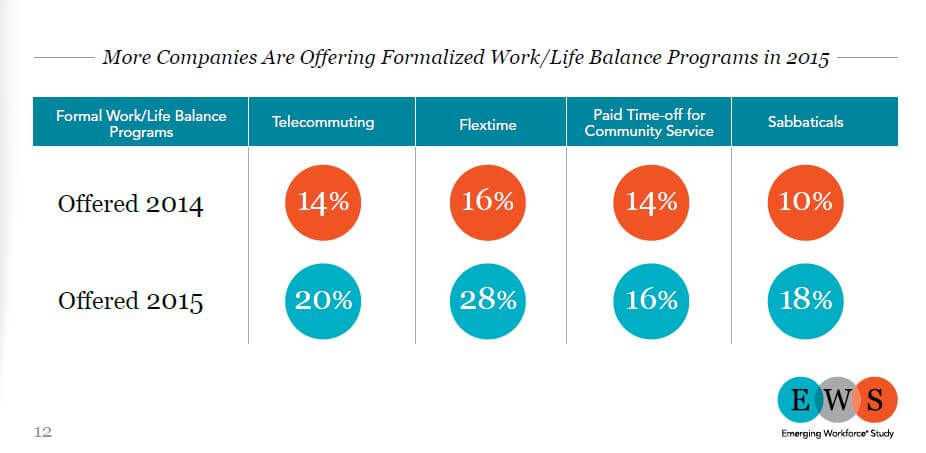I’m a sponsored blog partner with Spherion (a staffing and recruiting organization) and am participating in the release of findings from Spherion’s Emerging Workforce® Study (EWS). All opinions are mine.
When I was a kid, the cartoon The Jetson’s featured flying cars. Decades later, we still aren’t flying around like George Jetson. All that time ago, humans could envision individual air transport, but it’s not a reality yet. Predicting the future is a heck of a lot easier than making it come true. (Just ask Google how easy it is to get people to accept self-driving cars.)
The same came be said of the “workplace of the future.” What will that look like? Like transportation preferences, workplaces are equally slow to evolve. Even so, we can still draw upon what’s happening right now to take a guess as to the workplace that employers should create for the future. Spherion’s Emerging Workforce Study identified an interesting trend in organizational benefits: programs centered on offering more work/life balance to employees. (Some also call it “work/life integration.”)
At the heart of these programs is a very specific employee need: flexibility. Employees crave flexibility so they can take care of issues outside of work, without feeling stressed about “personal time off” or number of sick days taken.
Employers are responding to this need. According to the EWS, formal work-life balance programs are on the rise. Programs such as Flex-Time, Telecommuting, Paid time off for community service and Sabbaticals were all offered more frequently in 2015 than in 2014.

Employers feel these programs are well worth the effort. 81% report higher worker satisfaction, and nearly 75% say that these programs boost productivity.
Yet there is a shadow side to these glowing statistics. Work/Life Balance programs are great—if you are eligible to use them. As HR consultant Robin Schooling points out in her post The HR Hamster Wheel, not all employees qualify for flexible work schedules. Production, fulfillment and customer-facing jobs are highly structured and less likely to support a flex-time arrangement. That’s most likely why nearly one-third of employees surveyed for the Emerging Workforce Study indicated they were only “somewhat satisfied” or “not satisfied at all” with their current work/life balance programs.
According to these stats, a third of your workforce still hasn’t found the flexibility they need to fully integrate their work and outside-of-work life. You’ll never get to 100% satisfaction, but there is still opportunity to improve. Start with your management team. How can they involve employees to determine the best ways to offer flexibility within the unique constraints of their departments? Even highly structured operations have managed to find ways to help employees get the flexibility they crave.
Will the future hold “self-motivating” employees like the “self-driving” cars touted by Google? We’ll have to wait and see. In the meantime, you can help improve employee satisfaction and productivity by thinking about ways to offer flexibility in your department or organization.
About the Emerging Workforce Study: For more than 18 years, Spherion has examined the issues and trends impacting employment and the workforce. This year, Spherion’s “Emerging Workforce Study” was conducted between March and April of 2015 by Harris Poll, a Nielsen company. The study polled over 2,000 workers and 225 human resource managers on their opinions and attitudes regarding important workplace topics such as employee engagement, job satisfaction, generational differences and work/life balance. One of the study’s goals was to look for indicators for what the workplace will become. As the perspectives and attitudes of the workforce evolve, employers must better understand employees for greater business success.
You can also follow Spherion on Twitter (hashtag #EWS2015) or join them on Facebook.
Disclosure: Spherion partnered with bloggers (like yours truly) for their Emerging Workforce Study program. As part of this program, I received compensation for my time. I was free to form my own opinions about the data supplied by Spherion and all opinions are my own. Spherion’s policies align with WOMMA Ethics Code, FTC guidelines and social media engagement recommendations.
Leave a Reply